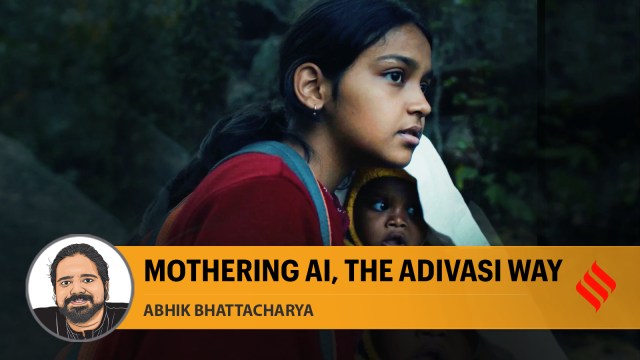
Dipesh Chakrabarty, in his book Provincialising Europe, questioned the universalisation of “modernity” as an idea. Since the 19th century, concepts like secularism, liberalism and modernity, and their markers, have been mostly read as “neutral” and “natural.” The socio-political contexts and the material referents that produced these abstract ideas gradually vanished into thin air, except where they were scrutinised and unpacked by the postcolonial scholars. Now, as Artificial Intelligence (AI) starts to shape socio-political discourse, one must stand against the Western bias in the data that feeds its worldview, because today’s bias could well become tomorrow’s “norm”, at least in terms of representation.
Aranya Sahay’s debut film, Humans in the Loop, initially released in 2024 but globally recognised and awarded in 2025, questions such bias in data labelling — the process of feeding data into AI — and reimagines training the technology in an Adivasi way. Set in a village deep inside Jharkhand, the film follows the life of Nehma, a divorced Adivasi woman, who joins a data labelling centre working for a US-based company, so that she can get custody of her teenage daughter, Dhannu, and toddler, Guntu.
However, this data-feeding is not a “neutral” effort; it is ideologically-charged and driven by the Western gaze. In one scene, Nehma is asked to label pests in a given set of images to equip AI-driven pest killers in the future. She carefully follows the instructions, but is unable to understand why caterpillars should be marked as “pests.” Refusing to conform to the non-Adivasi understanding of what is and isn’t a pest, Nehma leaves the photo unmarked. When questioned, she replied, “This is not a pest. It only eats the rotten part of the leaves.”
The sidelining of the perspective of the indigenous people, despite their hard labour in mothering AI, is what shapes Sahay’s intricate narrative. The silencing of one narrative in favour of another to create a dominant AI model is nothing but reinforcement of Western hegemony, and women like Nehma challenge it.
The symbiotic relationship between indigenous communities and nature, where even a porcupine is shown guiding Nehma’s daughter when she is lost in the forest, defies the modern understanding that sees the world in terms of resources. The binary of useful and harmful is turned on its head in Nehma’s understanding of pests. Further, the way Nehma teaches her daughter to pluck vegetables without affecting others adds nuance to the mechanical understanding of utilitarianism. The film shows that when AI is taught about the world and its resources, there might be a possibility to train it with the nuances of the marginalised, instead of mere mathematical categorisation. Sahay’s Humans in the Loop offers a peek into such efforts that could potentially revolutionise AI’s worldviews.
When Nehma’s boss, who is first perturbed by her defiance over the question of the caterpillar, asks AI to show images of Indian tribal women, its intrinsic bias is exposed. It produces pictures of white women with some markers of “perceived” indigenous cultures — like a romanticised headgear or a flower stuck in the hair. These pictures in no way represent the realities of Nehma and others like her. But as a mother and a trainer, Nehma knows the way out. She feeds her images, clicked by her daughter, into the machine. In the next search, the technology shrugs off its inherent bias and delivers an image that is closer to the reality of “tribal woman in Jharkhand.” Nehma’s boss then exclaims, “AI is like a child…It can change. It just needs time and a whole lot of data.”
Beyond this schema of preferential data feeding and competitive perceptions lies the mother in Nehma, who chooses to “mother” an AI so that she may be her own children’s legally recognised mother. The blurring of these lines between AI-human, human-nature and nature-AI is what makes Sahay’s film a masterpiece. Its use of silence, the absence of Savarna romanticism and lack of melodrama keep the audience focused on Nehma’s resilience and innovation. Without saying so explicitly, Humans in the Loop makes one thing clear: It is our turn to provincialise AI.
abhik.bhattacharya@expressindia.com